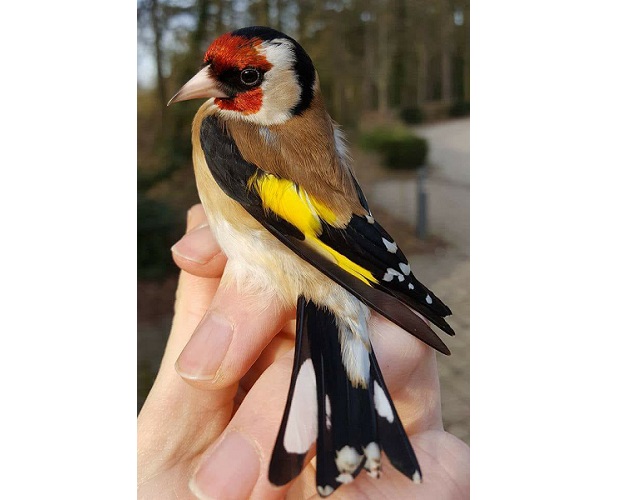It’s not every day that you get to share an experience quite as captivating as this. Jack Baddams, ornithologist and heritage facilitator at Creswell Crags in North Nottinghamshire, tells us about ringing of the birds at the Crags.
Drawn from a breathable cloth bag, like a rabbit from a hat, comes the most exquisite creature. With a mask of iridescent crimson and a vibrant splash of brightest yellow, this ornithological jewel that has just been revealed is a stunning goldfinch.

It had been harmlessly captured only moments before, expertly extracted from the net and placed in the bag to keep it calm. It doesn’t flutter frantically to escape or shriek with fright as many might expect, but instead sits looking regal, without a feather out of place.
The bird was being ringed – fitted with a small metal ring around its leg with a unique inscription. It weighs nothing to the bird and is no more notable to it than a wearing a wrist watch is to us. The ring will stay with it forever and allows us to gather all kinds of information about its life.
Ringing has paved the way for our understanding of migration by allowing us to recognise birds as individuals when they travel from one spot to another. Here at Creswell Crags, some of the siskins we have ringed (a small, handsome green and yellow finch) have turned up in Northumberland, Scotland and south Wales. A blackbird found one day was even carrying a ring on it from Norway!
The ring the bird carries also allows us to identify them throughout their lives and so lets us understand how long they live. The humble robin is a good example of what ringing has taught us about birds’ lifespans. Many people fall into the trap of thinking they’ve had the same robin visiting their garden year after year after year. However, we now know that they really only have an average lifespan of about two years – so your one robin is more likely to be three or four!
One of the great things about bird ringing at Creswell Crags is how we use it to educate and inspire the public. Demonstrations that we run allow people to watch and learn about what we do, how we do it and why it’s important for research and conservation. It’s not just a chance to teach people about bird ringing, but also inspire them to engage with nature in a unique way.
The watching crowd are enthralled by the goldfinch and, after being fitted with the ring and carefully aged, measured and weighed, the time comes for release. This honour is given to a member of the public and tends to be the highlight of the whole thing for adults and children alike.
The young girl who has volunteered to release the goldfinch holds it gently, feeling the soft feathers and rhythm of its tiny heartbeat against her hand. She slowly begins to uncurl her fingers and, for a half second, the bird sits on her hand before realising it’s free to leave. In a flash it’s gone, flicking from her outstretched palm to the trees in an instant. The girl gazes up after it, beaming from ear to ear before the goldfinch drifts off into the sky as though nothing had happened.
It’s a once in a lifetime experience for many people – being able to hold a wild bird for the briefest of moments and appreciate it in all its intricate splendour. It’s these special flashpoints that that can spark a lifelong interest in nature. To me, that’s why doing these bird ringing demonstrations is such a joy. Protecting nature isn’t just about collecting data to understand wildlife, but also about inspiring the next generation into thinking it is something worth saving. At Creswell Crags, we are lucky enough to be able to do both.
If you wish to join in with any of the bird ringing demonstrations we run throughout the year, please get in touch by calling 01909 720378, or email info@creswell-crags.org.uk.
Related
Comments
Veronika We are exactly the generation that still has the opportunity to enjoy the beauty of these birds. And we can do everything to keep this magic. You can find out more about it here https://featherlink.org/

 to add an item to your Itinerary basket.
to add an item to your Itinerary basket.










